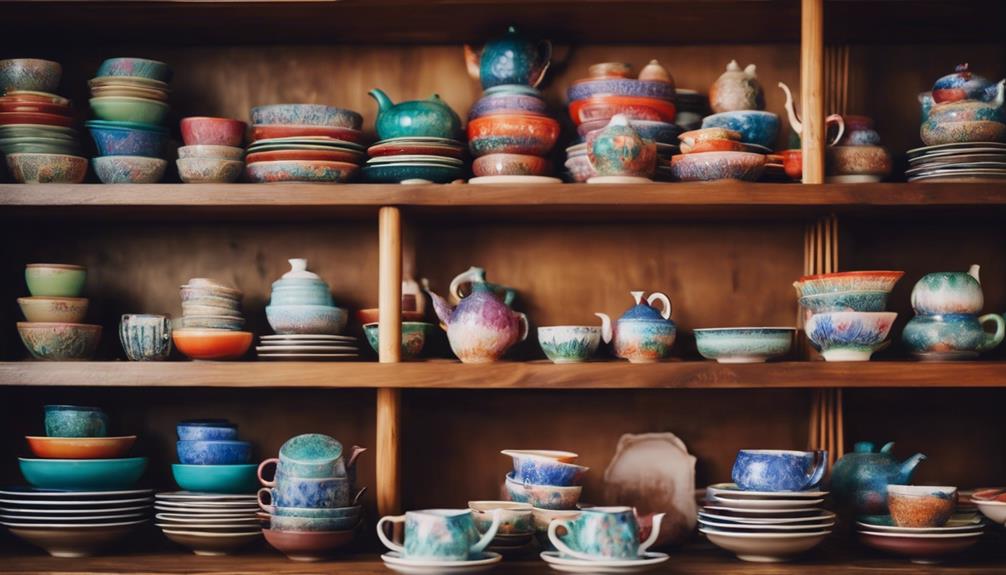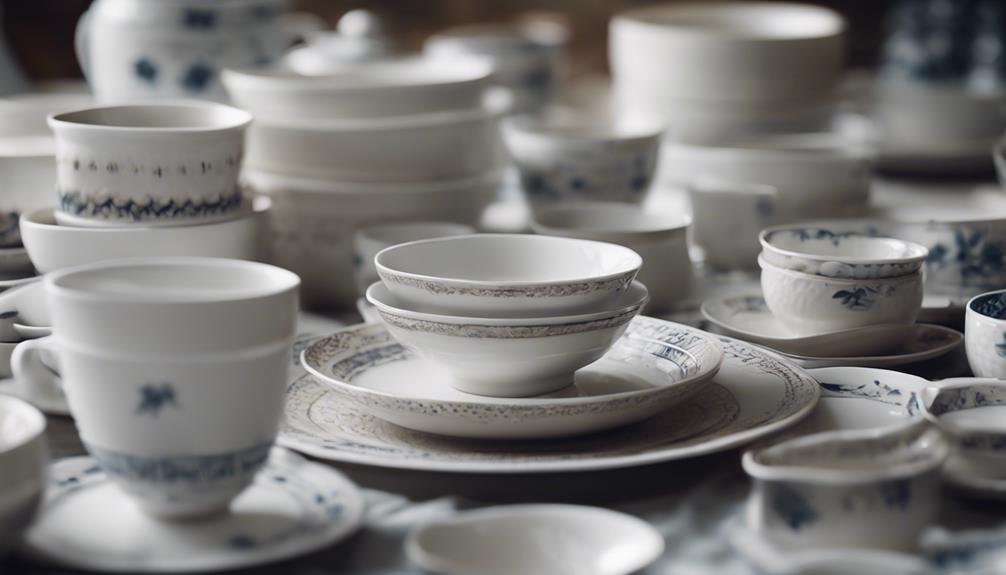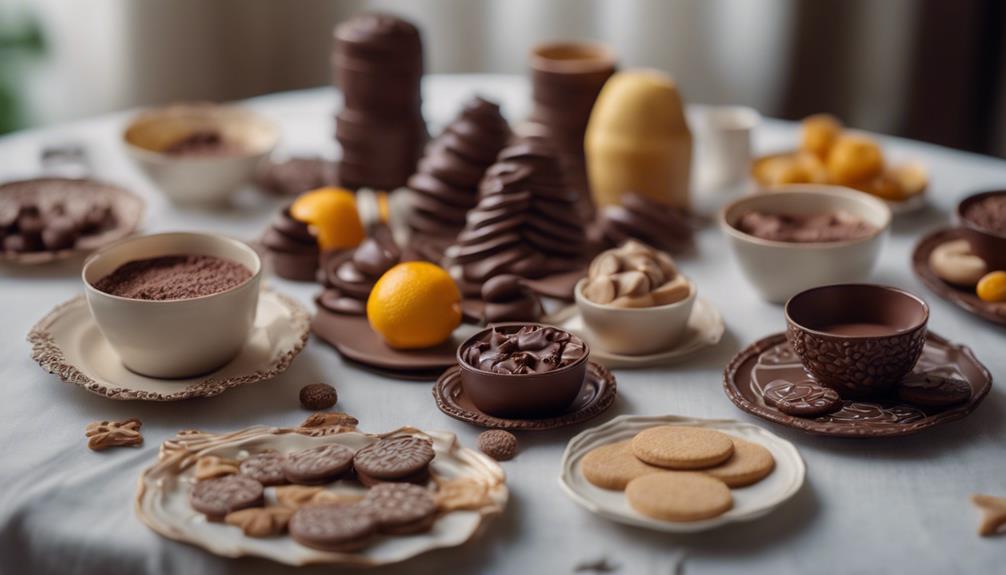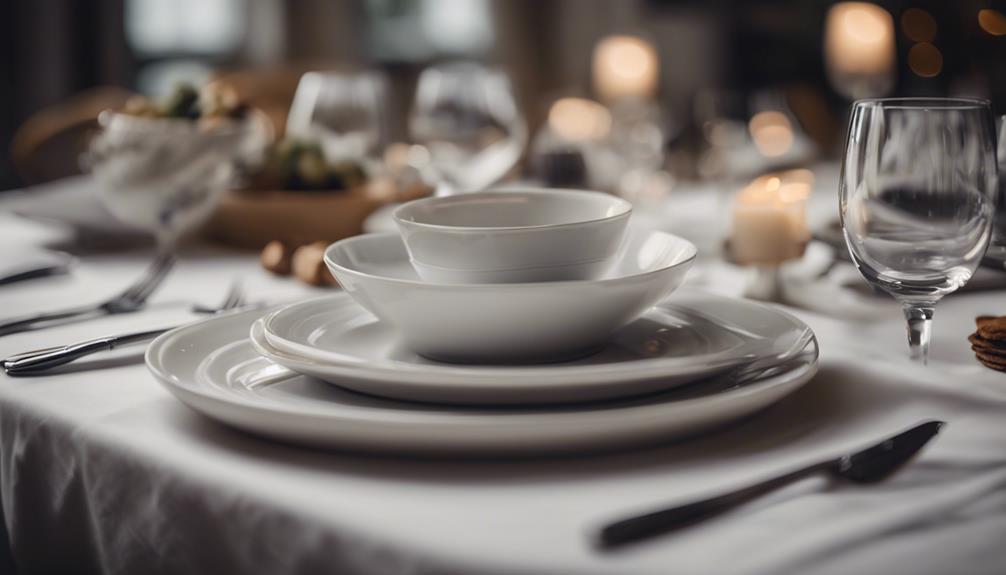Pewter tableware, a traditional kitchen essential with a history dating back centuries, is a tin alloy known for its gray-silver appearance, durability, and versatility in dining. Celebrated for its enduring appeal and usefulness, pewter pieces add sophistication to any table setting, perfect for both formal occasions and everyday meals. Comprising a blend of tin, copper, and antimony, this alloy is distinguished by its timeless grace and strength, making it a favored option for those who appreciate tradition and practicality. To learn more about the intricate designs, care recommendations, and contemporary uses of pewter tableware, delve deeper to enhance your knowledge of this esteemed dining staple.
Key Takeaways
- Pewter tableware is a type of tableware made of a tin alloy with copper and antimony.
- It boasts intricate designs, durability, and a distinctive grayish-silver appearance.
- Maintaining pewter tableware involves gentle cleaning, drying, and occasional polishing.
- It is versatile, suitable for various dining occasions, and enhances the overall dining experience.
- Pewter tableware combines classic elegance with modern sophistication, appealing to those seeking practicality and style.
Origins of Pewter Tableware

The origins of pewter tableware can be traced back to the 17th century, marking the beginning of its evolution in style until the 19th century. In ancient times, the production of pewter involved a mixture of tin and other metals like copper and antimony. This alloy gave pewter its distinctive grayish-silver appearance and made it a popular choice for tableware due to its affordability and malleability.
During the 17th to 19th centuries, pewter tableware experienced significant advancements in design and craftsmanship. The production methods evolved, leading to the creation of intricate chargers, dishes, plates, and saucers that exhibited unique characteristics. Early British sadware, as pewter tableware was known, showcased specific design elements that set it apart from other types of tableware during that period.
The variations in rims, plates, and basin design not only added to the aesthetic appeal of pewter tableware but also helped differentiate between pieces from different time periods. This evolution in style contributed to the popularity of pewter tableware in households for its durability and decorative charm.
Composition of Pewter Alloy

Considering the main methods of crafting pewter tableware, you may find it intriguing to learn about the intricate composition of the pewter alloy. Pewter is primarily made from a tin alloy, typically consisting of around 94% tin, 1% copper, and 5% antimony in the European casting alloy.
These metals are combined to create a durable material suitable for crafting various tableware items. It's important to note that modern pewter tableware is lead-free, unlike older versions that contained lead. This change was implemented due to modern restrictions and concerns about the health implications of lead.
The absence of lead makes modern pewter lighter and less prone to tarnishing, enhancing its appeal for contemporary table settings. By understanding the composition of pewter alloy, you can appreciate the craftsmanship and safety standards that go into creating these elegant and functional pieces of tableware.
Design and Features of Pewter

Pewter tableware boasts a variety of intricate designs that showcase the craftsmanship developed over centuries.
The unique characteristics in rims, plates, and basins design of early British sadware set it apart from other styles.
Variations in these design elements not only add aesthetic appeal but also contribute to the durability of pewter tableware.
Pewter Tableware Aesthetics
With a history spanning from 1650 to the 19th century, the evolution of sadware styles showcases a fascinating interplay of changing aesthetics and craftsmanship. Pewter tableware, also known as 'sadware,' encompasses chargers, dishes, plates, and saucers.
Early British sadware is recognized for its unique variations in rim, plate, and basin design, showcasing intricate details and craftsmanship. The use of pewter in modern tableware continues to reflect historical and cultural influences on aesthetics, making it a sought-after choice for those who appreciate both tradition and style.
The modern pewter tableware maintains the elegance and charm of its historical counterparts while adapting to contemporary tastes, offering a blend of timeless beauty and functionality for your dining table.
Pewter Tableware Durability
You'll notice the enduring strength and reliability of pewter tableware in its thoughtful design and distinctive features.
The item, Beaded Porringer, showcases the durability that makes pewter tableware perfect for everyday use. Its sturdy construction guarantees longevity, with the capacity to withstand the rigors of daily meals. The intricate patterns and motifs not only add aesthetic appeal but also contribute to the overall durability of the piece.
As time passes, the unique luster of pewter develops a charming patina, enhancing its beauty and character. Handcrafted by skilled artisans, pewter tableware items like the Beaded Porringer exhibit superior craftsmanship.
The weight of pewter tableware provides a sense of quality and substance, elevating your dining experience with a touch of elegance.
Maintenance and Care Tips

To keep your pewter tableware looking its best, regularly clean it with warm, soapy water and a soft cloth.
Avoid using harsh chemicals or abrasive cleaners that could damage its luster.
Remember to dry your pewter thoroughly after washing to prevent water spots and stains.
Cleaning Pewter Surfaces
For best maintenance and care of pewter surfaces, clean pewter tableware using warm, soapy water and a soft cloth. Here are three essential tips to make sure your pewter stays in top condition:
- Use Mild Cleaning Agents: Stick to gentle cleaners like warm, soapy water to avoid damaging the surface of your pewter tableware.
- Avoid Abrasive Tools: Stay away from abrasive cleaners or scouring pads that can scratch and mar the appearance of your pewter items.
- Thoroughly Dry After Cleaning: After washing, make sure to dry your pewter thoroughly to prevent water spots or tarnishing. This step will help maintain the lustrous look of your pewter tableware.
Polishing for Shine
Achieve a shiny and lustrous appearance for your pewter tableware by regularly polishing it using a soft cloth and a non-abrasive metal polish. This simple maintenance routine helps guarantee a tarnishing-free and maintains the elegant look of your pewter pieces.
When polishing, be sure to avoid harsh chemicals or abrasive materials that could damage the surface of the tableware. By taking the time to polish your pewter regularly, you can extend its lifespan and keep it looking like new for years to come.
Embrace the beauty of your pewter tableware by incorporating this easy polishing process into your regular care routine to make sure it maintains its stunning appearance.
Storing Properly
Proper storage of pewter tableware is crucial in maintaining its pristine condition and extending its longevity. To guarantee your pewter stays in top shape, follow these tips:
- Keep it Dry: Store your pewter in a dry environment to prevent tarnishing and corrosion.
- Wrap with Care: Use soft cloths or paper towels to wrap individual pieces for protection.
- Avoid Heat and Sunlight: Keep your pewter away from sources of heat or direct sunlight to maintain its appearance.
Versatility in Dining Settings

In dining settings, pewter tableware offers a remarkable blend of elegance and functionality. From chargers to dishes, plates, and saucers, collectively known as 'sadware,' pewter tableware provides a versatile option for various dining occasions.
The evolution of sadware styles from the 17th century to the 19th century showcases unique characteristics, with early British sadware displaying distinctive rims, plates, and basin designs. Pewter tableware's wide range of design choices allows you to find pieces that suit your personal style and dining preferences.
Whether you prefer a traditional or modern aesthetic, pewter tableware can complement a wide range of dining settings. The historical evolution of pewter tableware reflects changes in dining preferences and cultural influences, making it a versatile choice for both formal and casual dining occasions.
With its elegant appearance and practical functionality, pewter tableware is a timeless option that can enhance the overall dining experience.
Popularity and Modern Applications

Pewter tableware continues to captivate modern dining enthusiasts with its timeless elegance and versatility, making it a cherished choice for various dining settings.
- Classic Appeal: Pewter tableware remains a popular option due to its classic and elegant appearance, adding a sophisticated touch to modern dining arrangements.
- Modern Applications: From fine dining restaurants to special occasions and home decor, pewter tableware finds its place in a variety of settings, showcasing its adaptability and charm.
- Versatile Elegance: Whether for formal dinner parties or casual gatherings, pewter tableware offers a versatile option that effortlessly enhances the ambiance of any dining experience.
The enduring popularity of pewter tableware can be attributed to its ability to blend tradition with contemporary style, creating a harmonious balance that appeals to those seeking both sophistication and practicality in their dining choices.
Frequently Asked Questions
Why Do We No Longer Use Pewter Tableware?
You no longer use pewter tableware due to health concerns from lead content in old pewter. Modern pewter is lead-free, making it safe for daily use.
Changing fashion trends and the popularity of other materials like pottery and glass also contributed to the decline in pewter tableware use.
Despite this, pewter remains popular for decorative pieces and jewelry.
Are Pewter Dishes Worth Anything?
Pewter dishes can hold significant value based on factors like age, condition, and rarity. Antique pieces from renowned makers or those with intricate designs may fetch higher prices.
Look for marks or hallmarks indicating the maker and age to gauge worth. Consulting experts or appraisers can help determine the value of your pewter dishes.
What's so Special About Pewter?
Pewter is special for its elegant appearance, historical significance, and versatility in creating various tableware items. Its unique charm lies in the craftmanship and design elements like rims, plates, and basins, often showcasing distinct British styles from the 17th to the 19th century.
The evolution of sadware reflects changing tastes and styles over time, making pewter tableware a timeless and cherished choice for those seeking sophistication in their dining experience.
Are Pewter Plates Safe to Eat On?
Yes, pewter plates are safe to eat on as long as they're lead-free. Modern pewter, made with tin, copper, and antimony, is free from harmful lead.
European pewter typically has 94% tin, 1% copper, and 5% antimony. Asian pewter may be softer with a higher tin content, still safe for food use.
Make sure your pewter tableware is lead-free to avoid any health risks.
Is Pewter Tableware a Type of Tableware?
Yes, pewter tableware is a type of tableware called “what is tableware called“. Pewter tableware is a popular choice for its elegant and timeless appearance. It is a versatile material that can be used for various types of tableware, including plates, bowls, and serving utensils.
Conclusion
To sum up, pewter tableware is like a timeless piece of art that adds elegance and charm to any dining experience.
Just as a skilled artist uses various tools to create a masterpiece, pewter tableware is crafted with precision and care to enhance your dining setting.
Its versatility and durability make it a practical choice for everyday use, while its classic design guarantees it will never go out of style.
Add a touch of sophistication to your table with pewter tableware.










